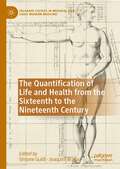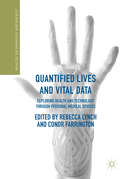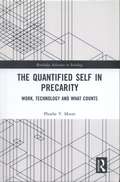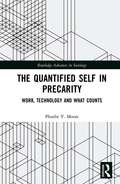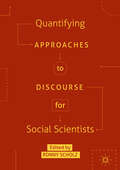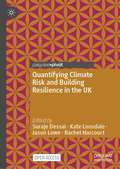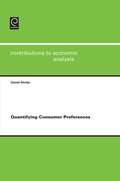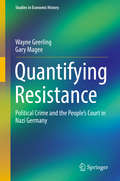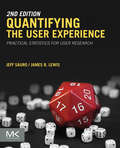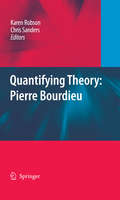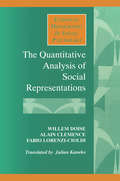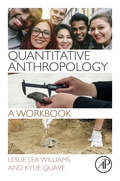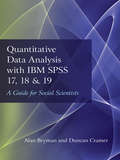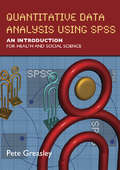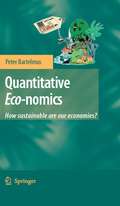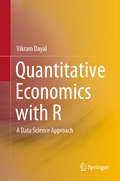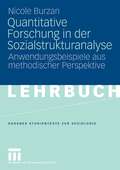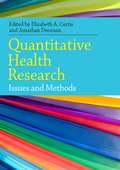- Table View
- List View
Quantenphysik und Esoterik: Über die innere Notwendigkeit renitenten Randgeschehens für die Autopoiesis von Funktionssystemen (Science Studies)
by Lisa Jane KlotzWie verhalten sich Quantenphysik und Esoterik zueinander? Lisa Jane Klotz zeigt, wie Quantenphysik in der Esoterik kommunikativ eingesetzt wird, um Geltungsansprüche zu legitimieren und zu plausibilisieren. Ihre Untersuchungen zu theoretischen und Experimentalphysikern erschließen darüber hinaus, dass sich die Bereiche Quantenphysik und Esoterik näher sind als gemeinhin angenommen. Der empirische Vergleich zweier so unterschiedlicher Systeme sagt ebenso viel über die divergente Alltagspraxis wie über ihre frappierende Ähnlichkeit auf systemtheoretischer Ebene aus - mit dem Ergebnis einer Erweiterung der Systemtheorie.
The Quantification of Life and Health from the Sixteenth to the Nineteenth Century: Intersections of Medicine and Philosophy (Palgrave Studies in Medieval and Early Modern Medicine)
by Simone Guidi Joaquim BragaThis edited volume explores the intersection of medicine and philosophy throughout history, calling attention to the role of quantification in understanding the medical body. Retracing current trends and debates to examine the quantification of the body throughout the early modern, modern and early contemporary age, the authors contextualise important issues of both medical and philosophical significance, with chapters focusing on the quantification of temperaments and fluids, complexions, functions of the living body, embryology, and the impact of quantified reasoning on the concepts of health and illness. With insights spanning from the sixteenth century to the nineteenth century, this book provides a wide-ranging overview of attempts to ‘quantify’ the human body at various points. Arguing that medicine and philosophy have been constantly in dialogue with each other, the authors discuss how this provided a strategic opportunity both for medical thought and philosophy to refine and further develop. Given today’s fascination with the quantification of the body, represented by the growing profusion of self-tracking devices logging one’s sleep, diet or mood, this collection offers an important and timely contribution to an emerging and interdisciplinary field of study.
Quantified Lives and Vital Data: Exploring Health and Technology through Personal Medical Devices (Health, Technology and Society)
by Rebecca Lynch Conor FarringtonThis book raises questions about the changing relationships between technology, people and health. It examines the accelerating pace of technological development and a general shift to personalized, patient-led medicine. Such relationships are increasingly mediated through particular medical technologies, drawn together by the authors as ‘personal medical devices’ (PMDs) – devices that are attached to, worn by, interacted with, or carried by individuals for the purposes of generating biomedical data and carrying out medical interventions on the person concerned. The burgeoning PMD field is advancing rapidly across multiple domains and disciplines – so rapidly that conceptual and empirical research and thinking around PMDs, and their clinical, social and philosophical implications, often lag behind new technical developments and medical interventions. This timely and original volume explores the significant and under-researched impact of personal medical devices on contemporary understandings of health and illness. It will be a valuable read for scholars and practitioners of medicine, health, science and technology and social science.
The Quantified School: Pedagogy, Subjectivity, and Metrics
by Diego SantoriThis book develops a theoretically rich analysis of quantification and subjectivity, tracing new linkages between educational policy and everyday life in schools, diving deeper into ‘ordinary’ schools as they encounter and navigate quantified forms of recognition. With a focus on Chile as a critical case of neoliberal experimentation, this book investigates whether intense exposure to quantified forms of meaning and sense-making in school settings could develop into metrics-driven dispositions or attachments. Contemporary demands on schools for calculation, prediction, and comparison by the use of accountability tools like high-stakes testing, league tables, consequential inspection ratings and ‘progress’ measures evidence the relentless presence of quantification in teaching and learning. This book argues the importance of bridging political, sociological and anthropological literatures together with affect and subjectivity theories to understand the complex ways in which standardisation, optimisation, automation, and surveillance crystallise into quantification-based forms of intelligibility.
The Quantified Self In Precarity
by Phoebe V. MooreHumans are accustomed to being tool bearers, but what happens when machines become tool bearers, calculating human labour via the use of big data and people analytics by metrics? The Quantified Self in Precarity highlights how, whether it be in insecure ‘gig’ work or office work, such digitalisation is not an inevitable process – nor is it one that necessarily improves working conditions. Indeed, through unique research and empirical data, Moore demonstrates how workplace quantification leads to high turnover rates, workplace rationalisation and worker stress and anxiety, with these issues linked to increased rates of subjective and objective precarity. Scientific management asked us to be efficient. Now, we are asked to be agile. But what does this mean for the everyday lives we lead? With a fresh perspective on how technology and the use of technology for management and self-management changes the ‘quantified’, precarious workplace today, The Quantified Self in Precarity will appeal to undergraduate and postgraduate students interested in fields such as Science and Technology, Organisation Management, Sociology and Politics.
The Quantified Self in Precarity: Work, Technology and What Counts (Routledge Advances in Sociology)
by Phoebe V. MooreHumans are accustomed to being tool bearers, but what happens when machines become tool bearers, calculating human labour via the use of big data and people analytics by metrics? The Quantified Self in Precarity highlights how, whether it be in insecure ‘gig’ work or office work, such digitalisation is not an inevitable process – nor is it one that necessarily improves working conditions. Indeed, through unique research and empirical data, Moore demonstrates how workplace quantification leads to high turnover rates, workplace rationalisation and worker stress and anxiety, with these issues linked to increased rates of subjective and objective precarity. Scientific management asked us to be efficient. Now, we are asked to be agile. But what does this mean for the everyday lives we lead? With a fresh perspective on how technology and the use of technology for management and self-management changes the ‘quantified’, precarious workplace today, The Quantified Self in Precarity will appeal to undergraduate and postgraduate students interested in fields such as Science and Technology, Organisation Management, Sociology and Politics.
The Quantified Self in Precarity: Work, Technology and What Counts (Routledge Advances in Sociology)
by Phoebe V. MooreHumans are accustomed to being tool bearers, but what happens when machines become tool bearers, calculating human labour via the use of big data and people analytics by metrics? The Quantified Self in Precarity highlights how, whether it be in insecure ‘gig’ work or office work, such digitalisation is not an inevitable process – nor is it one that necessarily improves working conditions. Indeed, through unique research and empirical data, Moore demonstrates how workplace quantification leads to high turnover rates, workplace rationalisation and worker stress and anxiety, with these issues linked to increased rates of subjective and objective precarity. Scientific management asked us to be efficient. Now, we are asked to be agile. But what does this mean for the everyday lives we lead? With a fresh perspective on how technology and the use of technology for management and self-management changes the ‘quantified’, precarious workplace today, The Quantified Self in Precarity will appeal to undergraduate and postgraduate students interested in fields such as Science and Technology, Organisation Management, Sociology and Politics.
The Quantified Self In Precarity (PDF)
by Phoebe V. MooreHumans are accustomed to being tool bearers, but what happens when machines become tool bearers, calculating human labour via the use of big data and people analytics by metrics? The Quantified Self in Precarity highlights how, whether it be in insecure ‘gig’ work or office work, such digitalisation is not an inevitable process – nor is it one that necessarily improves working conditions. Indeed, through unique research and empirical data, Moore demonstrates how workplace quantification leads to high turnover rates, workplace rationalisation and worker stress and anxiety, with these issues linked to increased rates of subjective and objective precarity. Scientific management asked us to be efficient. Now, we are asked to be agile. But what does this mean for the everyday lives we lead? With a fresh perspective on how technology and the use of technology for management and self-management changes the ‘quantified’, precarious workplace today, The Quantified Self in Precarity will appeal to undergraduate and postgraduate students interested in fields such as Science and Technology, Organisation Management, Sociology and Politics.
Quantifying Approaches to Discourse for Social Scientists (Postdisciplinary Studies in Discourse)
by Ronny ScholzThis book provides an overview of a range of quantitative methods, presenting a thorough analytical toolbox which will be of practical use to researchers across the social sciences as they face the challenges raised by new technology-driven language practices. The book is driven by a reflexive mind-set which views quantifying methods as complementary rather than in opposition to qualitative methods, and the chapters analyse a multitude of different intra- and extra-textual context levels essential for the understanding of how meaning is (re-)constructed in society. Uniting contributions from a range of national and disciplinary traditions, the chapters in this volume bring together state-of-the-art research from British, Canadian, French, German and Swiss authors representing the fields of Political Science, Sociology, Linguistics, Computer Science and Statistics. It will be of particular interest to discourse analysts, but also to other scholars working in the digital humanities and with big data of any kind.
Quantifying Climate Risk and Building Resilience in the UK
by Suraje Dessai Kate Lonsdale Jason Lowe Rachel HarcourtThis open access book draws together key research from the UK Climate Resilience programme. It focuses on topics central to the programme’s research agenda, including improved characterisation and quantification of climate risks, enhanced understanding of the management of climate risks, and the development and delivery of climate services. Key chapters address the challenges inherent to undertaking resilience research, including how to make the term ‘climate resilience’ usable and useful, co-producing research between academics, policy makers and practitioners, and engaging and communicating outside of academia. This book is unique in providing a concise and accessible overview of the programme’s key lessons, placing the findings into a wider context and it will inform future research, policy and practice agendas.
Quantifying Consumer Preferences (Contributions to Economic Analysis #288)
by Daniel SlottjeThis volume presents straightforward, innovative research on the estimation of demand systems and the measurement of consumer preferences. Demand studies and understanding consumer behavior remain two of the most important areas of analysis by practicing applied economists and econometricians. This volume also offers state of the art research in demand analysis, using modern econometric tools to analyze consumer behavior and estimate demand relationships for well known demand systems. This book will be aimed at a broad audience of economists and other social scientists; including generalists, graduate students, private sector economists and others.
Quantifying Resistance: Political Crime and the People’s Court in Nazi Germany (Studies in Economic History)
by Wayne Geerling Gary MageeThis book presents and uses a major, new database of the most serious forms of internal resistance to the Nazi state to study empirically the whole phenomenon of resistance to an authoritarian regime. By studying serious political resistance from a quantitative historical perspective, the book opens up a new avenue of research for economic history.The database underpinning the book was painstakingly compiled from official state records of treason and/or high treason tried before the German People’s Court (Volksgerichtshof) between 1933 and 1945. It brings together material on resistance groups stored in the archives of the Federal Republic of Germany and Austria with previously inaccessible files from the former German Democratic Republic, Czechoslovakia and Soviet Union. Through searching these records, the authors have been able to reconstruct in hitherto unattainable detail the economic, social, political, ethnic and familial profiles, backgrounds, and influences of all 4,378 civilians of the Third Reich active in Germany, Austria and the outside territories for whom there are complete records.The findings of their research afford fresh, new interdisciplinary insights and perspectives, not only on the configuration, timing, impact and profile of resistance to the Nazi state, but also on a range of real-world behaviours common within authoritarian states, such as defection, reward and punishment, and commitment to group identities. The book’s statistical analysis reveals precisely the who, how, where and when of serious resistance. In so doing, it advances significantly our understanding of the overall pattern and nature of serious resistance within Nazi Germany.
Quantifying the User Experience: Practical Statistics for User Research
by James R Lewis Jeff SauroQuantifying the User Experience: Practical Statistics for User Research, Second Edition, provides practitioners and researchers with the information they need to confidently quantify, qualify, and justify their data. The book presents a practical guide on how to use statistics to solve common quantitative problems that arise in user research. It addresses questions users face every day, including, Is the current product more usable than our competition? Can we be sure at least 70% of users can complete the task on their first attempt? How long will it take users to purchase products on the website? This book provides a foundation for statistical theories and the best practices needed to apply them. The authors draw on decades of statistical literature from human factors, industrial engineering, and psychology, as well as their own published research, providing both concrete solutions (Excel formulas and links to their own web-calculators), along with an engaging discussion on the statistical reasons why tests work and how to effectively communicate results. Throughout this new edition, users will find updates on standardized usability questionnaires, a new chapter on general linear modeling (correlation, regression, and analysis of variance), with updated examples and case studies throughout.Completely updated to provide practical guidance on solving usability testing problems with statistics for any project, including those using Six Sigma practicesIncludes new and revised information on standardized usability questionnairesIncludes a completely new chapter introducing correlation, regression, and analysis of varianceShows practitioners which test to use, why they work, and best practices for application, along with easy-to-use Excel formulas and web-calculators for analyzing dataRecommends ways for researchers and practitioners to communicate results to stakeholders in plain English
Quantifying Theory: Pierre Bourdieu
by Karen Robson Chris SandersPierre Bourdieu’s contributions to the theory and practice of social research are far reaching. Possibly the most prominent sociologist in recent times, his work has touched on a myriad of topics and has influenced scholars in multiple disciplines. Throughout Bourdieu’s work, emphasis is placed on the linkage between the practice of social research and its relationship to social theory. This book honours Bourdieu’s commitment to the inextricable relationship between social theory and research in social science. In this volume, authors from all over the world utilize key concepts coined by Bourdieu, specifically his concept of capitals, habitus, and the field, and attempt to test them using quantitative survey data. The focus of this volume is how researchers can take key elements of Bourdieu’s work and apply them to the analysis of quantitative data on a variety of topics. Throughout the volume, issues of the possible interpretations of concepts and measurement validity are focused upon in a language that can be appreciated by new and experienced researchers alike. This volume is useful for courses where the linkage between theory and research is emphasized, at both the upper undergraduate and general postgraduate level. In addition to serving as a teaching tool, the articles within the volume will be invaluable to any scholar interested in working with Bourdieu’s concepts in quantitative research.
The Quantitative Analysis of Social Representations (European Monographs in Social Psychology)
by Alain Clemence Willem Doise Fabio Lorenzi-CioldiFirst Published in 1995. Routledge is an imprint of Taylor & Francis, an informa company.
The Quantitative Analysis of Social Representations (European Monographs in Social Psychology)
by Alain Clemence Willem Doise Fabio Lorenzi-CioldiFirst Published in 1995. Routledge is an imprint of Taylor & Francis, an informa company.
Quantitative Anthropology: A Workbook
by Leslie Lea Williams Kylie QuaveQuantitative Anthropology: A Workbook contributes an anthropological perspective to quantitative methods. The book's authors address characteristics of quantitative data, entering and manipulating data in SPSS, graphical displays, distributions and measures of central tendency and dispersion, and including hypothesis testing with both parametric and nonparametric statistical tests. Increasingly complex exercises build on cumulative learning from chapter to chapter and stress the application of methods beyond coursework. The focus of the manual is on univariate statistical analysis, and the book is written to be accessible to higher level undergraduate students and graduate students in all fields of anthropology.Uses anthropological examples (from the subdisciplines of sociocultural anthropology, biological anthropology, and archaeology) to illustrate quantitative data techniquesIntegrates quantitative techniques with theoretical fluency, encouraging the reader to make connections between Big Picture questions in anthropology and the methods used to address those questionsFocuses on the practical use of Excel and SPSS to apply quantitative methods to anthropological contextsIncludes exercises in both parametric and nonparametric inferential statistics, as well as descriptive statistics
Quantitative Data Analysis with IBM SPSS 17, 18 & 19: A Guide for Social Scientists (1st Edition)
by Alan BrymanThis latest edition has been fully updated to accommodate the needs of users of SPSS Releases 17, 18 and 19 while still being applicable to users of SPSS Releases 15 and 16. As with previous editions, Alan Bryman and Duncan Cramer continue to offer a comprehensive and user-friendly introduction to the widely used IBM SPSS Statistics. The simple, non-technical approach to quantitative data analysis enables the reader to quickly become familiar with SPSS and with the tests available to them. No previous experience of statistics or computing is required as this book provides a step-by-step guide to statistical techniques, including: Non-parametric tests Correlation Simple and multiple regression Analysis of variance and covariance Factor analysis. This book comes equipped with a comprehensive range of exercises for further practice, and it covers key issues such as sampling, statistical inference, conceptualization and measurement and selection of appropriate tests. The authors have also included a helpful glossary of key terms. The data sets used in Quantitative Data Analysis with IBM SPSS 17, 18 and 19 are available online at http://www.routledgetextbooks.com/textbooks/author/bryman-9780 415579193/; in addition, a set of multiple-choice questions and a chapter-by-chapter PowerPoint lecture course are available free of charge to lecturers who adopt the book.
Quantitative Data Analysis with IBM SPSS 17, 18 & 19: A Guide for Social Scientists (1st Edition) (PDF)
by Alan BrymanThis latest edition has been fully updated to accommodate the needs of users of SPSS Releases 17, 18 and 19 while still being applicable to users of SPSS Releases 15 and 16. As with previous editions, Alan Bryman and Duncan Cramer continue to offer a comprehensive and user-friendly introduction to the widely used IBM SPSS Statistics. The simple, non-technical approach to quantitative data analysis enables the reader to quickly become familiar with SPSS and with the tests available to them. No previous experience of statistics or computing is required as this book provides a step-by-step guide to statistical techniques, including: Non-parametric tests Correlation Simple and multiple regression Analysis of variance and covariance Factor analysis. This book comes equipped with a comprehensive range of exercises for further practice, and it covers key issues such as sampling, statistical inference, conceptualization and measurement and selection of appropriate tests. The authors have also included a helpful glossary of key terms. The data sets used in Quantitative Data Analysis with IBM SPSS 17, 18 and 19 are available online at http://www.routledgetextbooks.com/textbooks/author/bryman-9780 415579193/; in addition, a set of multiple-choice questions and a chapter-by-chapter PowerPoint lecture course are available free of charge to lecturers who adopt the book.
Quantitative Data Analysis with SPSS: An Introduction For Health And Social Sciences (UK Higher Education OUP Humanities & Social Sciences Health & Social Welfare)
by Pete Greasley"This is an ideal introductory book for budding researchers who are embarking on the development and then analysis of data, and in this case, more specifically questionnaires using partly or exclusively closed questions amenable to statistical analysis."Primary Health Care Research and Development"The text is a welcome addition for nursing students at both undergraduate and postgraduate level research. Having reviewed the text I can only inform you how a student described a chapter in the book recently when she borrowed it. 'The language is clear and unambiguous'. I will be strongly encouraging students to either purchase the text ... with the purpose of giving them a foundation in statistics."William Evans, Institute of Technology Tralee, IrelandThis accessible book is essential reading for those looking for a short and simple guide to basic data analysis. Written for the complete beginner, the book is the ideal companion when undertaking quantitative data analysis for the first time using SPSS. The book uses a simple example of quantitative data analysis that would be typical to the health field to take you through the process of data analysis step by step. The example used is a doctor who conducts a questionnaire survey of 30 patients to assess a specific service. The data from these questionnaires is given to you for analysis, and the book leads you through the process required to analyse this data. Handy screenshots illustrate each step of the process so you can try out the analysis for yourself, and apply it to your own research with ease.Topics covered include: Questionnaires and how to analyse them Coding the data for SPSS, setting up an SPSS database and entering the data Descriptive statistics and illustrating the data using graphs Cross-tabulation and the Chi-square statistic Correlation: examining relationships between interval data Examining differences between two sets of scores Reporting the results and presenting the dataQuantitative Data Analysis Using SPSS is helpful for any students in health and social sciences with little or no experience of quantitative data analysis and statistics.
Quantitative Eco-nomics: How sustainable are our economies?
by Peter BartelmusThis thought-provoking and colorful book cuts through the fog of vision and advocacy by comparing and applying new quantitative tools of both environmental and ecological economics. Environmental accounts and empirical analyses provide operational concepts and measures of the sustainability of economic performance and growth. The text raises doubts, however, about the measurability of sustainable development. Further reading sections are provided at the end of each chapter.
Quantitative Economics with R: A Data Science Approach
by Vikram DayalThis book provides a contemporary treatment of quantitative economics, with a focus on data science. The book introduces the reader to R and RStudio, and uses expert Hadley Wickham’s tidyverse package for different parts of the data analysis workflow. After a gentle introduction to R code, the reader’s R skills are gradually honed, with the help of “your turn” exercises. At the heart of data science is data, and the book equips the reader to import and wrangle data, (including network data). Very early on, the reader will begin using the popular ggplot2 package for visualizing data, even making basic maps. The use of R in understanding functions, simulating difference equations, and carrying out matrix operations is also covered. The book uses Monte Carlo simulation to understand probability and statistical inference, and the bootstrap is introduced. Causal inference is illuminated using simulation, data graphs, and R code for applications with real economic examples, covering experiments, matching, regression discontinuity, difference-in-difference, and instrumental variables. The interplay of growth related data and models is presented, before the book introduces the reader to time series data analysis with graphs, simulation, and examples. Lastly, two computationally intensive methods—generalized additive models and random forests (an important and versatile machine learning method)—are introduced intuitively with applications. The book will be of great interest to economists—students, teachers, and researchers alike—who want to learn R. It will help economics students gain an intuitive appreciation of applied economics and enjoy engaging with the material actively, while also equipping them with key data science skills.
Quantitative Forschung in der Sozialstrukturanalyse: Anwendungsbeispiele aus methodischer Perspektive (Studientexte zur Soziologie)
by Nicole BurzanDas Buch blickt aus methodischer Perspektive auf konkrete Anwendungsbeispiele der quantitativen Sozialstrukturforschung. Beispiele für methodische Herausforderungen und Lösungen hinsichtlich des Forschungsablaufs, der Datenerhebung und Auswertung sind die Messung von Armut, Alter als Lebensphase, bildungsspezifische Partnerwahl, Einstellungen zu sozialer Ungleichheit im internationalen Vergleich sowie soziale Netzwerke von Müttern. Im Mittelpunkt stehen nicht Durchführungsweisen statistischer Verfahren, sondern die Verknüpfung von Forschungsmethoden mit Inhalten.
Quantitative Health Research Methods: Issues And Methods (UK Higher Education OUP Humanities & Social Sciences Health & Social Welfare)
by Elizabeth Curtis Jonathan DrennanThis book is a detailed and comprehensive guide to undertaking quantitative health research at postgraduate and professional level. It takes you through the entire research process, from designing the project to presenting the results and will help you execute high quality quantitative research that improves and informs clinical practice.Written by a team of research experts, this book covers common practical problems such as applying theory to research and analysing data. It also includes chapters on communicating with ethics committees, recruiting samples from vulnerable populations, audit as a research approach, quasi-experimental designs and using cognitive interviewing, making it a new and innovative offering for health researchers. Other topics covered in this book include: Ethical considerations of researchDesigning and planning quantitative research projectsData measurement and collectionAnalyzing and presenting resultsWith a strong practical focus, each chapter features examples of real-life research to illustrate the quantitative research process, as well as tips and insights into research planning and execution. This book is an essential guide for all health care professionals undertaking a postgraduate degree, as well as health researchers and practitioners who need to carry out research as part of their professional role. Contributors: Ruth Belling, Michelle Butler, Catherine Comiskey, Siobhan Corrigan, Gloria Crispino, Orla Dempsey, Suzanne Guerin, Maree Johnson, Carmel Kelly, Elaine Lehane, Maria Lohan, Susan McLaren, Deirdre Mongan, Corina Naughton, Rhona O'Connell, Elaine Pierce, Gary Rolfe, Eileen Savage, Anne Scott, Emma Stokes, Roger Watson "“Learning quantitative research is taken much for granted. This is probably why there are fewer generic books on quantitative than qualitative research. This book is long overdue. Clearly- written and well structured, it takes us through the whole journey of a research project from developing 'research questions' to 'presenting the findings', passing through philosophical underpinnings, recruitment of participants and ethical considerations. Written by an array of well-known researchers and teachers, this book will certainly appeal to new as well as seasoned researchers. Those who will use it, will not be disappointed."Kader Parahoo, University of Ulster "The title of this text is somewhat misleading. It is not only an excellent and thorough guide to qualitative health research methods; it is also an excellent introduction to all forms of qualitative research. It takes the reader gently through theoretical and ethical concerns to the practicalities and benefits of utilising qualitative approaches. As such it is that rare thing; a text that can be used by novice researchers to learn their craft, and a key reference resource for experienced research practitioners." Dr. John Cullen, School of Business, National University of Ireland, Maynooth, UK"This is a first-rate collection of essays that promotes an informed understanding of both underpinning principles and widely used techniques. A great deal of effort has clearly been invested in co-ordinating the contributions, and this has delivered clarity, complementarity and effective coverage. This is a welcome, carefully-crafted and very accessible resource that will appeal to students and researchers in healthcare and beyond." Martin Beirne, Professor of Management and Organizational Behaviour, University of Glasgow, Adam Smith Business School, UK
Quantitative Intertextuality: Analyzing the Markers of Information Reuse
by Christopher W. Forstall Walter J. ScheirerThis book introduces quantitative intertextuality, a new approach to the algorithmic study of information reuse in text, sound and images. Employing a variety of tools from machine learning, natural language processing, and computer vision, readers will learn to trace patterns of reuse across diverse sources for scholarly work and practical applications.The respective chapters share highly novel methodological insights in order to guide the reader through the basics of intertextuality. In Part 1, “Theory”, the theoretical aspects of intertextuality are introduced, leading to a discussion of how they can be embodied by quantitative methods. In Part 2, “Practice”, specific quantitative methods are described to establish a set of automated procedures for the practice of quantitative intertextuality. Each chapter in Part 2 begins with a general introduction to a major concept (e.g., lexical matching, sound matching, semantic matching), followed by a case study (e.g., detecting allusions to a popular television show in tweets, quantifying sound reuse in Romantic poetry, identifying influences in fan faction by thematic matching), and finally the development of an algorithm that can be used to reveal parallels in the relevant contexts.Because this book is intended as a “gentle” introduction, the emphasis is often on simple yet effective algorithms for a given matching task. A set of exercises is included at the end of each chapter, giving readers the chance to explore more cutting-edge solutions and novel aspects to the material at hand. Additionally, the book’s companion website includes software (R and C++ library code) and all of the source data for the examples in the book, as well as supplemental content (slides, high-resolution images, additional results) that may prove helpful for exploring the different facets of quantitative intertextuality that are presented in each chapter.Given its interdisciplinary nature, the book will appeal to a broad audience. From practitioners specializing in forensics to students of cultural studies, readers with diverse backgrounds (e.g., in the social sciences, natural language processing, or computer vision) will find valuable insights.

